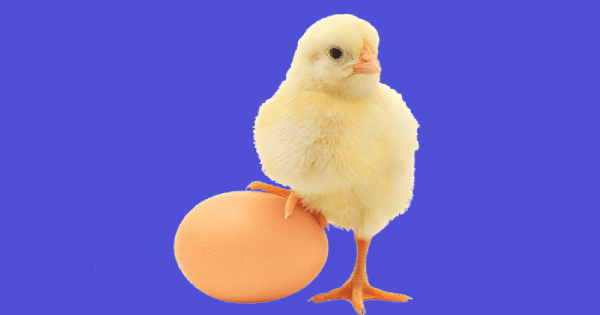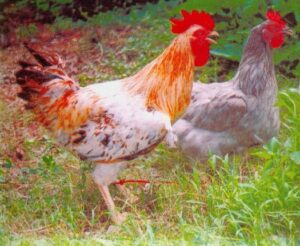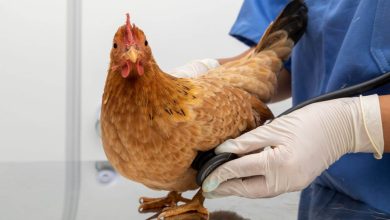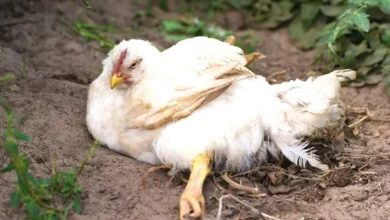Prospects of Backyard Poultry Farming in India

S. K. Joshi1*, J. Udgata1 and S. Sathapathy2
1Krishi Vigyan Kendra, OUAT, Jharsuguda – 768202
2Department of Anatomy and Histology, C.V.Sc. and A.H., OUAT, Bhubaneswar – 751003
*Corresponding email: suman42.joshi@gmail.com
Introduction
Rural population living in India constitutes 72.22 per cent of the total population, which is predominantly occupied by the poor, marginal farmers and landless labourers. Livestock and poultry sector provides the baseline of employment and earning to these people to raise their standard of living and thereby has a major contribution to India’s economy. Poultry as an important supplementary source of cash income is reared by about 89 percent of rural livestock householders. Poultry farming is widely possible in different agro-climatic environments, as fowls have marked physiological adaptability. It requires small space, less capital investment, also in poultry farming there is quick return and well distributed turn-over throughout the year, which makes it remunerative in rural as well as urban areas. Traditional backyard poultry production in India is practiced since time immemorial which was the primary source of animal protein and supplementary income for the down trodden rural poor and only source of poultry egg and meat for city dwellers before poultry industrialization. Importance of backyard poultry production has been globally recognized to overcome the worsening problems of poverty, hunger and malnutrition in developing countries. Poultry is one of the fastest growing segments of the agricultural sector in India today. While the production of agricultural crops has been rising at a rate of 1.5—2% per annum, that of eggs and broilers has been rising at a rate of 8—10% per annum. National annual consumption is 37 billion eggs and one billion broilers.
Backyard poultry production forms the basis for transforming the rural poultry sector from subsistence to a more economically productive base. Also, increased backyard poultry production would result in a positive impact on household food security both in terms of increased dietary intake as well as income generation. Hence, increasing meat and egg production from backyard poultry has been a major concern of Government of India for many years and supported by various programmes to improve backyard poultry production. This has resulted in release of some important backyard poultry varieties viz., Debendra, Giriraja, Gramapriya, Krishna-J, Swarnadhara, Vanaraja etc.
Utility of Backyard Poultry Farming
Backyard poultry, a traditional system of poultry keeping is a part of livestock rearing practiced by rural folks since time immemorial. It is a type of organic farming with no harmful residue in egg and meat. It is an eco-friendly approach. Further, these are very active in pest control, provide manure and required for special festivals and traditional ceremonies. Backyard poultry is advantageous as it provides supplementary income in shortest possible time with very minimum capital investment, simple in operation and ensures availability of egg and meat even in remote rural areas. As the local birds are used mostly, they got better adaptability and protect themselves from predators and diseases. Backyard poultry, due to its least demanding nature in terms of infrastructure has been widely accepted by the rural poor. Backyard poultry in India is characterized by small flock size consisting of 5-10 predominantly non-descript birds maintained in extensive system under zero or low input venture. It is characterized by indigenous night shelter, scavenging system with little supplementary feeding and natural hatching of chicks due to this the system auto-regenerates. Mainly local birds are reared although there are specific or specialized indigenous breeds in some areas. These breeds represent a rich source of disease resistant germplasm. The native chicken varieties adopted in free- range backyard conditions for centuries contribute about 11% of total egg production in India. In most of the cases, eggs produced are for home consumption or for limited trade within the village.
Backyard poultry production plays a vital role in rapid growth of economy. It provides livelihood security and availability of food to the family. Unemployed youth and women can also earn an income through poultry farming. Besides income generation, Rural backyard poultry provides the demand of nutrition supplementation in the form of valuable animal protein through meat and eggs to the rural families. It has also been noticed that the demand for rural backyard poultry is quite high in tribal areas.
Challenges in rural poultry farming in tribal areas
The native chicken varieties adopted in the free range backyard conditions in tribal areas have low productivity and their contribution to the total egg output is almost static for the last few decades. Therefore, the consumption of eggs in the tribal areas is far below the national average across the country. Increasing the genetic potential of the local chicken varieties greatly helps in increasing the availability of poultry products in tribal areas. The chicken varieties being used in the intensive poultry farming cannot survive in free-range, where the disease challenge is high, climatic variations are harsh and adverse and vary greatly from place to place and season to season. Adapting the intensive poultry farming in small scale in tribal areas may not be economically viable due to limitations in management, high input cost and non-availability of inputs in rural/ tribal areas. However, due to non-availability of poultry products, the prices are up to double in tribal areas compared to those prevailing in the other part of the country. Therefore, it is necessary to popularize suitable chicken varieties, which can thrive in backyard free-range conditions without expensive inputs like commercial feed, supplement and medicine etc. Predator menace, harsh and diversified climatic conditions, diseases, consumer preferences, lack of commercial feed etc. are some of the major issues, which need attention while popularizing birds suitable for free range backyard farming. Adapting rural poultry farming in backyards of household can ensure the the availability of eggs and meat in rural and under developed areas; which will heil in alleviating the incidence of protein deficiency particularly in tribal areas.
Management
Backyard germplasm can scavenge well for its feed in the fields (Table 2). During the process of scavenging on grass fields these birds will have an access to insects, white ants, green grass, grass seeds, waste grains etc, thereby the supplemental feed requirement is lesser than those reared under intensive poultry farming. Feed supplementation in the form of scratch usually given in the morning/evening to develop habit to reach owner’s place for laying eggs and for night shelter. Depending on the availability of free range area and also the intensity of vegetative growth, the requirement of supplemental feed varies between 25 and 50 g/bird/day. These birds can also perform well on whole grain feeding under scavenging conditions.
Free-range Poultry Farming
Free range system is best adapted to small- scale farmers who raise chicken for sale. Free-range extensive poultry farming (Fig. 1.2) is commonly practiced in Africa and Latin America. This low-cost free range system increases the commercial value of poultry. Under free-range conditions, the birds are not confined and can scavenge for food over a wide area. They are often kept in movable houses surrounded by fence. Their position is changed on a regular basis, so that the birds have access to a more or less constant supply of fresh green vegetation, with some insects, worms and other natural food. This is similar to systems in North America called Range Poultry or Pasture Poultry. Here, rudimentary shelters may be provided which may or may not be used by birds. The birds may perch outside, usually in trees and nest in the bush. As such, there is no practice of feeding not even handful of grains. The flock contains birds of different species and varying ages. The growth rate and egg production is very less. Usually, non-descript fowls are reared in this system. Extensive range poultry production requires more land and is usually part of a diversified operation with cattle, sheep, goat, pig, rabbit etc. Soil fertility is a major motivation and producers are able to take advantage of the poultry manure to improve their pastures for ruminants.
Both backyard and free range systems are extensive system of rearing the poultry with many similarities between them which are as follows:
- These are as such not an occupation but a supplementary household activity to farmers.
- In both the conditions, the high yielding exotic varieties fail to give better results. So, the non-descript or crossbred fowls are used.
- Both systems of rearing are usually found in rural areas unlike commercial poultry which is more in peri-urban and urban areas.
Varieties Developed For Backyard Poultry Farming in India
In rural areas of India, chicken reared are mostly desi type with low egg and meat production and there is need of introduction of improved dual purpose bird having capacity to lay more eggs and gain higher body weight than the local or desi birds. Realizing the importance of backyard rural poultry farming (RPF) in India, several research organizations developed different backyard chicken varieties.
- Varieties developed by CARI
Five important varieties of backyard poultry are developed by Central Avian Research Institute (CARI) which are detailed below:
- CARl Debendra
This is a medium-sized dual-purpose bird suitable for backyard rural poultry production system (Fig. 1). It was developed by crossing coloured synthetic broiler line as male line and Rhode Island Red (RIR) as female line at Central Avian Research Institute (CARI), Izatnagar – 243 122 (UP). The bird achieves moderate body weight of 1200 g at eight weeks of age with economic feed conversion ratio of 2.6. The meat has lower carcass and abdominal fat than broiler meat, which makes it a consumer’s delight. It is a suitable bird for rural poultry because of its better survivability and moderate egg production ability. From 100 Debendra birds under semi-scavenging system, 20000 brown-shelled eggs can be obtained per year with a net return of Rs. 25,000.
Fig. 1: CARI Debendra
(ii) CARI Nirbheek
It is a cross of Indian native breed Aseel with CARI Red developed for free range as well as backyard poultry production (Fig. 2). These are very active birds, large in size, aggressive in nature with high stamina and majestic gait. They are able to save themselves from predators due to their fighting characters and activeness. They are also adopted to all climatic zones of the country for backyard production.
Fig. 2: CARI Nirbheek
(iii) CARI Upcari
CARI Upcari has been developed utilizing Indian native chicken with Frizzle plumage (Fig. 3). These are multicoloured birds with single comb and medium body size. Presence of Frizzle plumage helps in fast dissipation of heat due to which birds are better adopted specially in tropical climate in arid zones under backyard production.
Fig. 3: CARI Upcari
( iv ) CARI Hitcari
This variety has been developed utilizing Indian native chicken with naked neck plumage, which are adapted to tropical climate especially for hot and humid coastal regions of the country. These multicoloured birds have single as well as pea comb and birds are larger in built (Fig. 4).
Fig. 4: CARI Hitcari
( v ) CARI Shyama
It is a cross of Kadaknath breed of Indian native chicken with CARI Red. Birds have plumage of various colours dominated by black (Fig. 5). The skin, beak, shank, toes and soles are dark gray in colour. The peculiarity of this bird is that most of the internal organs (muscles and tissues) show the characteristics black pigmentation. The black colour of muscles and tissues is due to deposition of melanin pigment, which causes increase in protein and decrease of fat and muscle fibre.
Fig. 5: CARI Shyama
( B ) Giriraja and Swarnadhara
Giriraja and Swarnadhara varieties were developed by Karnataka Veterinary, Animal and Fishery Sciences University, Bangalore. The hybrid coloured chicken variety named Giriraja (Fig. 6) was developed for backyard rearing by College of Veterinary Science, Bangalore. The birds have a high egg production potential along with better growth compared to local varieties and are suited for mixed and backyard farming. Giriraja female lays about 130-150 eggs a year. Each egg weighs about 52-55 g. The eggs have a good hatchability (80-85 per cent) and enable the farmers to raise their own stock. Day-old chick weighs about 42-45g. The eggshell is brown in colour and thicker than that of other commercial eggs and does not break easily. The eggs are priced at a premium rate of Rs. 3 to 4 in the local market. For backyard rearing, a flock of five hens and one cock can be ideally grown. No special care is required to grow them. They can be raised as free roaming birds and can be fed with locally available materials. Being good scavengers, they feed on a variety of insects and green foliage. They can also be fed on farm and kitchen waste. The birds are resistant to many diseases except Ranikhet disease.
Swarnadhara chickens have a high egg production potential along with better growth compared to other local varieties and are suited for mixed and backyard farming. The bird can be reared for its eggs and meat. It attains maturity from the 22-23rd week after hatching. Hens attain a body weight of about 3 kg and cocks about 4 kg. “Swarnadhara hens lay about 180-190 eggs in a year. When compared to Giriraja, this breed yields 15-20 eggs more in a year. Swarnadhara breed (Fig. 7) is smaller in size when compared to Giriraja with a lighter body weight, which makes them easier to escape attacks from predators such as jungle cats and foxes. Each egg weighs about 55-60 g with good hatchability (80-85 per cent) and enable the farmers to raise their own stock. A day-old chick weighs about 35-40 g. The eggshell is brown in colour and thicker than that of other commercial eggs and does not break easily. The eggs can be stored for 8-10 days at room temperature during summer and during winter for about 15 days. The eggs are priced between Rs.3 and 5 in the local market. The birds are only layers and not brooders. The eggs have to be hatched by local brooder hens. For backyard rearing, a flock of five hens and one cock can be ideally grown. The birds are sturdy and have a high longevity. No special care is required to grow them. They can be raised as free roaming birds and can be fed with locally available materials. Being good scavengers, they feed on a variety of insects and green foliage. They can also be fed on farm and kitchen wastes. The birds are resistant to major diseases except New Castle disease. A pair of Swarnadhara chicken fetches an income of about Rs.920 a year through the sale of its eggs and meat. One-day-old chicks and eggs of this breed are priced at Rs. 9 and Rs. 5, respectively.
Fig 6. Giriraja
Fig 7. Swarnadhara
- Vanaraja
Vanaraja is a choice bird for backyard farming in rural and tribal areas developed by the Project Directorate on Poultry (PDP), Hyderabad (Andhra Pradesh). It is a multi-coloured dual purpose bird with attractive plumage (Fig. 8). The male parent is a coloured cornish strain and the female parent is a synthetic multi-coloured meat strain. The male parent has been developed for moderate juvenile body weight, long shanks and good immuno-competence. The female parent has been developed for high egg production, better egg size, high hatchability and immune competence. The plumage pattern and colour of Vanaraja bird is very attractive and closely resembles that of the desi fowl. It has better immune status against common poultry diseases and is adaptable to the backyard rearing. The general resistance to common poultry diseases and the ability to withstand adverse climatic conditions makes Vanaraja perform well in rural areas. Due to their relatively light weight and long shanks, these birds are capable to protect themselves from predators which are otherwise a major problem observed in birds reared in backyard. Further, the genetic potential of Desi hens can be improved by crossing them with Vanaraja males and the upgraded progeny of such a cross performs better than Desi bird for body weight and egg production. Vanaraja males attain moderate body weight at 8 weeks of age under regular feeding system and the pullets produce around 160-180 eggs in a laying cycle with minimum supplementation of locally available feed ingredients and other managemental inputs.
Day old Vanaraja chicks need brooding up to 4-6 weeks of age. They should be protected against Ranikhet disease through proper vaccination programme. During brooding period, they can be fed with layer starter diet. After brooding, these chicks need initial acclimatization to backyard environment before they are let free. Once they get adapted to the backyard farming conditions, they can perform better by scavenging for feed in the backyards. Additional feed need to be offered to the birds depending upon the extent of vegetation in the backyard and open area available for scavenging.
Fig 8. Vanaraja
Advantages of backyard poultry farming
- Provides additional income and employment to the rural households (women).
- It integrates well with other agricultural operations, so extra or in additional land is not required.
- Aids in enhancing the soil fertility in backyards (15 chickens produce 1- 1.2 kg of manure/ day).
- Produce of rural poultry farming fetches high price compared to those produce from intensive poultry farming.
- Waste material (insects, ants, fallen grains, green grass, kitchen waste, vegetable waste etc.) can be efficiently converted in to egg and chicken meat for human consumption.
- Alleviates protein malnutrition in vulnerable groups viz. expectant women, feeding mothers and children.
- Eggs and meat from birds reared under free range conditions have low cholesterol concentration compared to those produced under intensive poultry farming.
Constraints faced in Traditional Backyard poultry farming
- Lack of technical knowledge.
- Lack of suitable germplasm.
- Decrease in availability of natural resources of feed.
- Inadequate Veterinary support.
Popularization of Backyard Poultry Farming in Rural India
Backyard poultry farming plays an important role in providing income and protein to local rural people with minimal resource input. Although several organizations such as NGO’s, KVK’s, SAU’s has initiated to popularize the traditional Backyard poultry farming, it needs a lot more to be done to overcome its constraints so that backyard farming can be undertaken by each and every family of villages for their upliftment as far as possible.
Conclusion
The eggs and meat of birds reared in the backyard farming fetches higher premium due to high consumer acceptability even in the urban sectors where plenty of eggs and poultry meat from commercial units are available. Besides stable supply of high-quality animal food, backyard poultry production promotes income opportunities particularly for the weaker sections in the tribal areas. The backyard farming will certainly improve the economic status of a majority of rural/tribal families from lower socio-economic groups in the rural/tribal areas. Backyard farming fulfill a wide range of functions e.g. the provision of meat and eggs, food for special festivals, chicken for traditional ceremonies, pest control and petty cash, utilizing minimum inputs, minimum human attention, and causing less environmental pollution.
References
- Ghosh, M. K., Ahmed, F. A., Buragohain, R., Pathak , P. K. and Bhattacharya, M. 2005. Growth performance of Vanaraja birds in high altitude areas of Arunachal Pradesh under Backyard system of management. XXII Annual conference and National Symposium, Indian Poultry Science Association, Project Directorate on Poultry, Hyderabad, from 2-4 February 2005. pp 198.
- GOI. 2005. Mid Term Appraisal of the Tenth Five Year Plan (2002—2007) Planning Commission, Government of India.
- GOI. 2006. Report of the Working Group on Animal Husbandry and Dairying for the Eleventh Five Year Plan (2007—2012). Planning Commission, Government of India.
- GOI. 2008. National Livestock Policy 2008. Department of Animal Husbandry, Dairying and Fisheries. Ministry of Agriculture. Government of India.
- Khandait, V.N., Gawande, S.H., Lohakare, A.C. and Dhenge, S.A., 2011. Adoption level and constraints in Backyard Poultry Rearing Practices at Bhandra District of Maharashtra (India). Research Journal of Agricultural Sciences. 2(1): 110-113.
- Kumaresan, A., Bujarbaruah, K. M., Pathak, K. A., Chettri, B., Ahmed, S. K. and Haunshi, S. 2008. Analysis of a village chicken production system and performance of improved dual purpose chickens under a subtropical hill agro- ecosystem in India. Tropical Animal Health Production, 40 : 395-402.
- Mehta, R., Nambiar, R.G., Delgado, C., Subramanyam, S. 2003. Livestock industrialization project : phase II—Policy, technical, and environmental determinants and implications of the scaling-up of broiler and egg production in India. IFPRI-FAO project on Livestock Industrialization, Trade and Social-Health Environment impacts in Developing Countries.
- Nath, B. G., Pathak, P. K. and Mohanty, A. K. 2012. Constraints Analysis of Poultry Production at Dzongu Area of North Sikkim in India. Iranian Journal of Applied Animal Science, 2 (4) : 397-401.













I lost 2000 Vanaraja birds within one week due to Ranikhet/ IBD . Doctors tried their best but it spread like epidemic.Not a single bird could be saved.It is a very risky business as there are no remedial medicine or preventive vaccination.
Entrepreneurs please take your own decision after risk assessment.
KB livestock Farm, Really very useful information, It is motivating my career. I recommended from your website details everyone read more. KB livestock Farm: kadaknath chicken and chicks for sell. The best, leading kadaknath poultry farm website lists kadaknath chicken for sale in India. http://www.kblivestockfarm.com
Kadaknath poultry is good income source for farmer